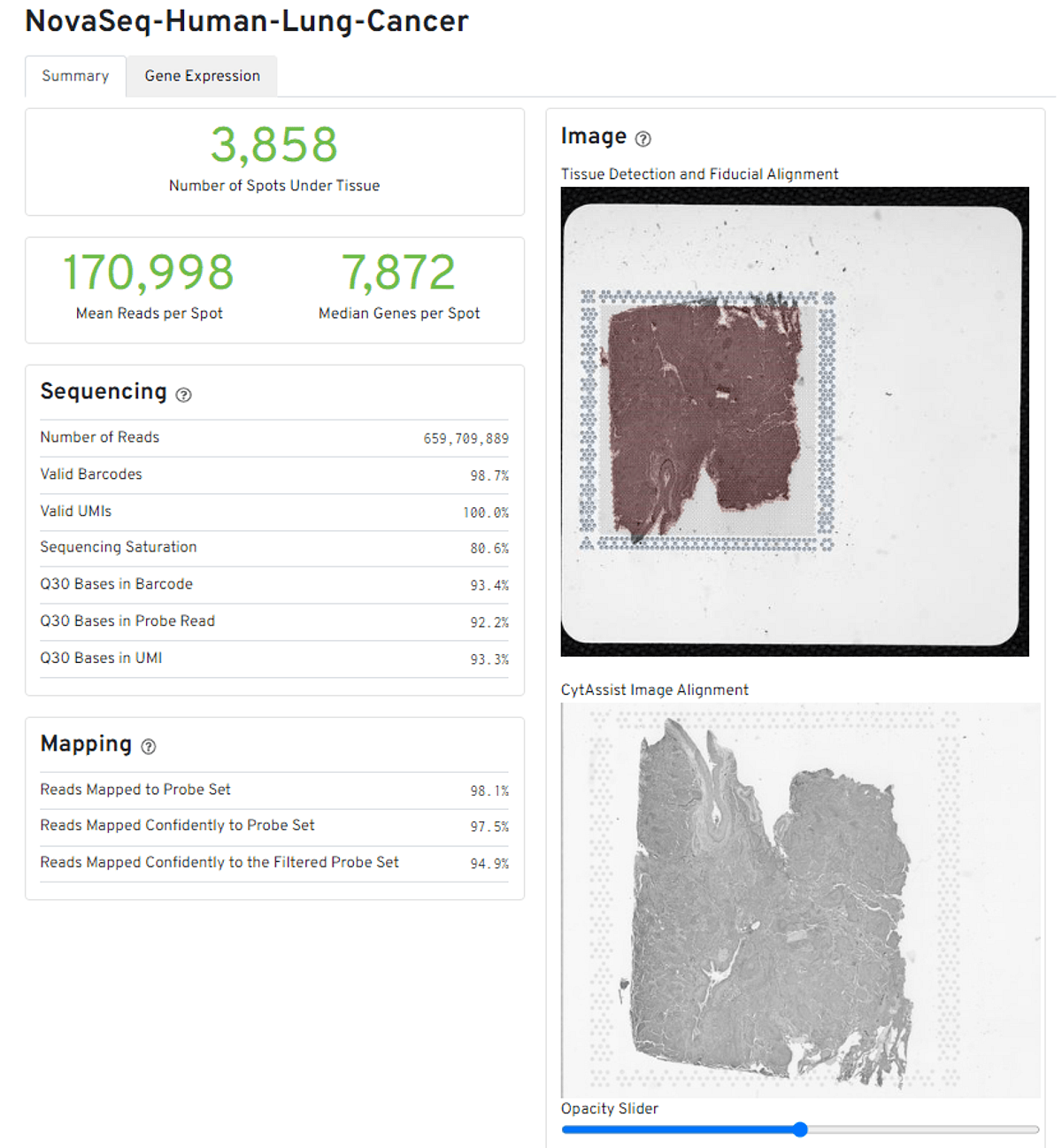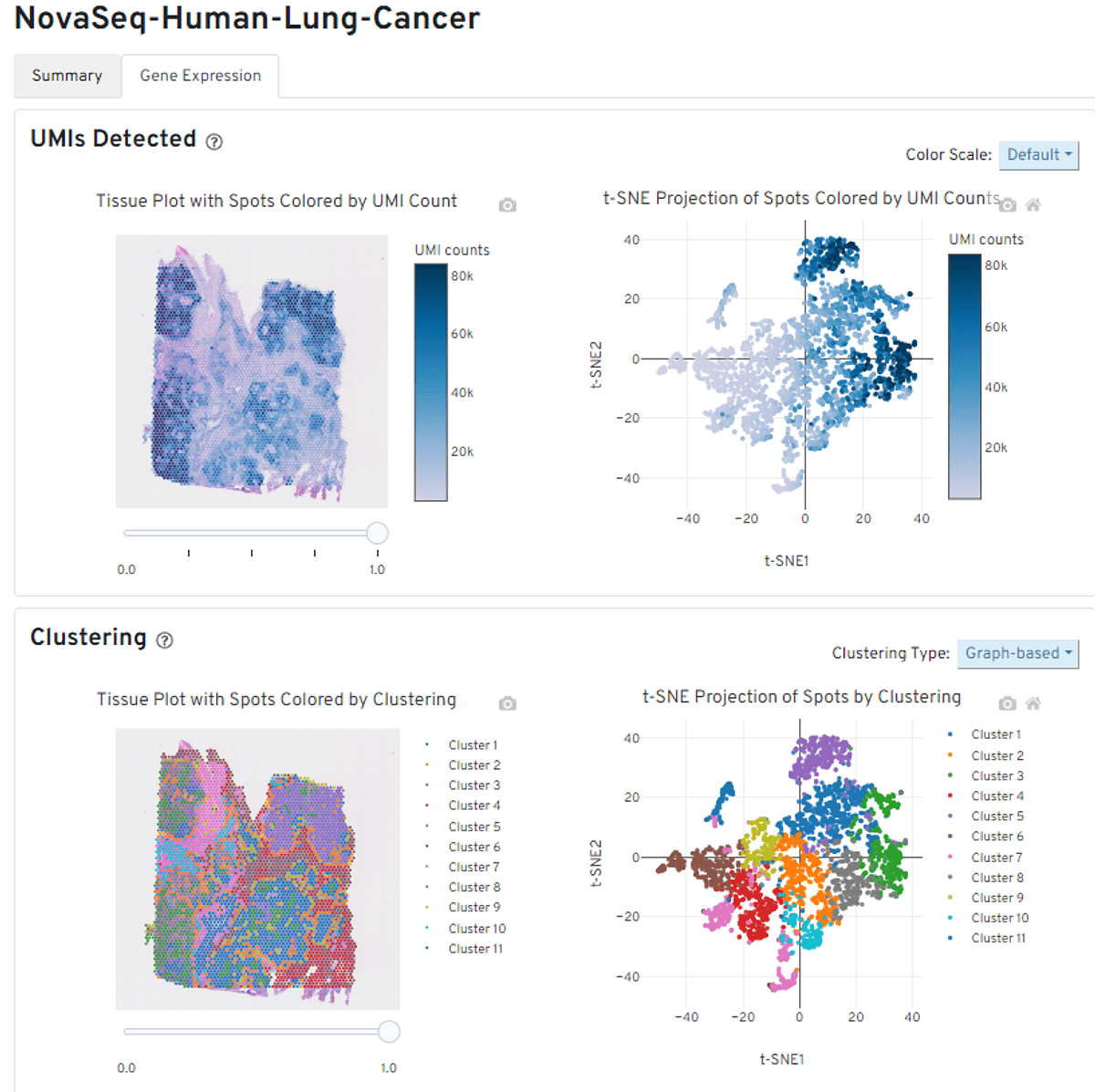- Home
- News & Updates
- 10x Genomics’ Visium FFPE with CytAssist data now available on Illumina® BaseSpace™ Sequence Hub
-
BaseSpace™ Sequence Hub
-
Publications
-
News
- 06/20/2023
10x Genomics’ Visium FFPE with CytAssist data now available on Illumina® BaseSpace™ Sequence Hub
Today, we’re continuing a series of posts that shed more light on new run data publicly available on BaseSpace™ Sequence Hub (BSSH) for applications like spatial transcriptomics.
Spatial transcriptomics experiments combine molecular and morphological characterization to provide a previously inaccessible view of tissue biology. 10x Genomics is a partner that develops multiple single cell and spatial biology solutions. 10x Genomics Visium CytAssist is a compact instrument designed to facilitate the transfer of transcriptomic probes from standard glass slides to Visium slides, enabling spatial profiling insights to be gained from an extensive range of FFPE and Fresh Frozen samples.
Today, we are excited to announce that we have published sequencing data for this product on BaseSpace™ Sequence Hub. 3 FFPE sample types (human ovarian cancer, human lung cancer and human melanoma) processed with 10x Genomics Visium CytAssist were sequenced on the NextSeq™ 2000 P3 flow cell, and another set of libraries were sequenced on a NovaSeq™ 6000 S1 v1.5 flow cell. Datasets for these samples can be downloaded from the 10x Genomics website.

Figure 1: In the Visium CytAssist workflow, sectioning, deparaffinization (if needed), and staining and imaging (H&E or IF) take place on a standard glass slide. After transcriptomic probe hybridization, two standard glass slides and a two–Capture Area Visium slide are placed in the CytAssist instrument so that the tissue sections on the standard slides can be aligned on top of the two Visium Capture Areas. Within the instrument, a brightfield image is captured to provide spatial orientation for data analysis, followed by hybridization of transcriptomic probes to the Visium slide. The remaining steps, starting with probe extension, follow the standard Visium for FFPE workflow outside of the instrument.
The Visium CytAssist assay from 10x Genomics is compatible with all Illumina® platforms, but we recommend using NextSeq™ 550/1000/2000 and NovaSeq™ 6000/X to be able to sequence multiple samples per run. The recommended sequencing depth is a minimum of 25k read pairs per spot covered with tissue. Sequencing depth can be adjusted based on the required performance and application – see 10x Genomics website for more details. The recommended read length is 28 bp for Read 1, 10 bp for Index 1 (i7) and Index 2 (i5) and 50 bp for Read 2 (reverse read). 10x Genomics recommend to spike in 1% PhiX in the sequencing run.
10x Genomics’ Visium CytAssist workflow runs available on BSSH demo data page
To view a set of sequencing runs for Visium CytAssist libraries run on both NextSeq™ 2000 P3 flow cells and NovaSeq™ 6000 S1 v1.5 flow cells, please visit BaseSpace™ Sequence Hub. Check our previous blog post on our Demo Data section in BaseSpace™ Sequence Hub for additional details on how to access published run data.
Below are two links to directly import the runs and project folders into your BaseSpace account. These runs can be found under the RNA-seq category. Because these are public data sets, these are free and do not count against storage limits.
You can use the demo data to compare with your own Visium CytAssist sequencing runs on Illumina platforms. See our first blog post in this series for additional details on how to evaluate your sequencing run quality.
Visium CytAssist run on NextSeq 2000: https://basespace.illumina.com/s/GkbF6B7CuN2S (650 pM loading concentration)
Visium Cytassist Project on NextSeq 2000: https://basespace.illumina.com/s/phmxEDUXRgKr
Visium CytAssist run on NovaSeq 6000: https://basespace.illumina.com/s/2w7ihFh3CyVl (XP workflow, 50 pM loading concentration)
Visium CytAssist Project NovaSeq 6000: https://basespace.illumina.com/s/pwoOdluYIIpa
Access the 10x Genomics Space Ranger html report for the Visium CytAssist
The HTML run reports from Space Ranger have been uploaded to the project, under the “Analyses” tab. The HTML report files generated by Space Ranger have been included in the project folder and can be downloaded from the “Files” tab (under the “Report html” folder).
The Space Ranger summary report contains summary metrics and automated secondary analysis results. The number of Spots Under Tissue, Mean Reads per Spot and median genes per spot are displayed in the summary tab. The gene expression tab includes the number of UMI detected per spot and clustering data.


Figure 2: Space Ranger data for the human lung cancer sample processed with Visium CytAssist and sequenced on the Illumina NovaSeq 6000.
Additional resources
If you need further assistance in sequencing Visium CytAssist libraries, you can contact the Illumina® (techsupport@illumina.com) and 10x Genomics (support@10xgenomics.com) support teams. These two teams collaborate to ensure you are fully supported throughout the workflow.
Visium CytAssist Resources
https://www.10xgenomics.com/resources/datasets/human-ovarian-cancer-11-mm-capture-area-ffpe-2-standard
https://www.10xgenomics.com/resources/datasets/human-lung-cancer-ffpe-2-standard https://www.10xgenomics.com/resources/datasets/human-melanoma-if-stained-ffpe-2-standard
https://pages.10xgenomics.com/rs/446-PBO-704/images/10x_LIT000128_Product_Sheet_Spatial_Biology_Without_Limits_Letter_digital.pdf
https://pages.10xgenomics.com/rs/446-PBO-704/images/10x_LIT059_ProductSheet_VisiumSpatialGeneExpression_Letter_digital.pdf
Illumina documentation
https://www.illumina.com/systems/sequencing-platforms/nextseq-1000-2000.html
https://www.illumina.com/systems/sequencing-platforms/novaseq.html
https://www.illumina.com/systems/sequencing-platforms/novaseq-x-plus.html
https://www.10xgenomics.com/products/single-cell-gene-expression-flex
Joint 10x Genomics – Illumina application note:
BaseSpace data with 10x Genomics Visium Gene Expression: https://developer.illumina.com/news-updates/10x-genomics-visium-spatial-gene-expression-data-now-available-on-illumina-basespace-sequence-hub
Special thanks to our colleagues at 10x Genomics for providing samples to sequence, and hat tip to Illumina Scientist Robin Bombardi and the Emerging Apps team for sequencing and analyzing these runs for this collaboration.
For Research Use Only. Not for use in diagnostic procedures. M-GL-01735